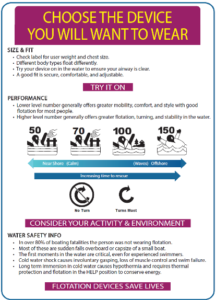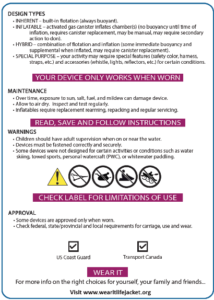Courtesy of the National Safe Boating Council
New Life Jacket Labels
APRIL 23, 2020 by National Safe Boating Council
Boaters love their gear, and most boaters have their favorite life jacket. As we head into boating season, it's time to inspect and test our gear before we hit the water.
When is the last time you tested your life jacket? While there is no expiration date, life jackets do have a life cycle, and depending on how you've maintained and stored your gear, it may be time to replace yours. Look for any tears or broken straps and buckles. If you find any, you should cut off any buckles that may be recyclable, use a sharpie to write on the life jacket that it's out of service, and toss the life jacket in the trash. If the life jacket appears to be in top condition, you should test for in-water performance by wearing your life jacket and submerging in a shallow area. Does it fit properly when submerged in water? Can you float on your back with enough buoyancy? All life jackets should be annually tested, and some more frequently depending on the manufacturer. It's helpful to use a sharpie to note a date on the inside of the life jacket to help you keep track when it was last tested.
If it's time to replace your life jacket, you may see a new label on new devices in the stores. The new labels are being phased in, and you may find some life jackets in the store with the new label and others still with the old label. The new labels don't make obsolete life jackets with the old label or life jackets you already own (you can continue to use your life jacket as long as they are serviceable).
The most important thing to remember in selecting a life jacket is to find the device that fits you snugly and comfortably, and that you will want to wear! What kind of life jacket do you want? You'll need to consider your body type, swim skills, boating activity and environment. Last year, 84% of drowning victims in recreational boating accidents were not wearing a life jacket.
First, check the label on the inside of the life jacket to find the U.S. Coast Guard approval number for that life jacket. This approval number is on both the old and new life jacket labels. If you see this, you can be assured that the life jacket has been thoroughly tested for performance. And, life jackets with the new labels are approved for use in Canada and the United States, whereas devices with the old labels continue to be approved in one country or the other, not both.
Next, the new labels have icons noting its performance level, turn ability, and warnings. These icons are international symbols adopted from the International Standards Organization (ISO) sub-committee for life jacket standards. The icons make it much easier to understand and choose the right device to use in its intended water activity.
The performance level icon is a combination of five factors – buoyancy, freeboard, turning, stability and visibility. A lower level number generally offers greater mobility, comfort, and style with good flotation for most people. These are intended for near shore (calm water) activities. The higher level number generally offers greater flotation, turning, and stability in the water. These are intended for offshore activity and when more time is needed in rescue situations. Right now in stores you'll find life jackets with the new label for Level 70 devices.
The turn ability icon will note if the life jacket will turn an unconscious wearer to their back. And, the warnings icons illustrate activities the life jacket is not designed for, such as whitewater.
If you're not sure what the icons mean, the life jacket will have a hang tag with a quick reference guide. There's also a website on the hang tag (and stamped on the inside of the life jacket) with additional information at wearitlifejacket.org. Life jackets with the old label will have the type system that is being phased out.


After you've reviewed the label and have selected a life jacket for your activity, try it on. While the size of the device is shown on the inside label (usually near the back of the neck) as a measure of weight, and sometimes includes a chest measurement or height, it's best to try it on as just like other clothing items, a life jacket will fit differently for each person. Also, try it out in the water!
Finally, once you've found the perfect fit, think more about your intended use for the life jacket. If you may spend time on the water on a PWC (personal watercraft), tow sports, or whitewater paddle, make sure the life jacket is approved for those activities. Many boaters opt to have a different style life jacket for different recreational boating activities.
For example, when flatwater paddling you may opt for an inflatable life jacket. These are great options, but be aware of your swimming abilities and environment, and make sure you understand how to activate, test, and properly wear an inflatable life jacket. And, boa
The most important thing to remember about life jackets is to always Wear It!

